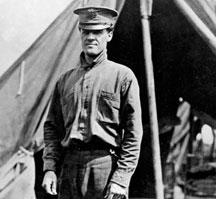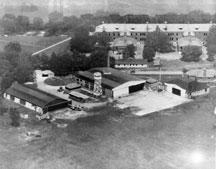|

|
| 1st Lt. Jarvis Jennes Offutt |

|
| Ft. Crook and Offutt Field |
For nearly a century, Offutt AFB has played a key role in American military history. From its beginnings
as Fort Crook in the late 1800s, Offutt has adapted to the defense needs of the United States. The historical significance
of Offutt is a source of pride for military and community members alike.
Offutt's great heritage began with the construction
of Fort Crook between 1894 and 1896, some 10 miles south of Omaha and two miles west of the Missouri River. The fort's namesake
was Maj. Gen. George Crook, a renowned Indian fighter and Civil War hero. Many of the original buildings constructed on the
post before 1900, including the guard house and various enlisted and officers quarters, are still in use today.
The
61st Balloon Company became the first air unit to command the post on Sept. 10, 1918. In the spring of 1921, the plowing,
leveling, and seeding of 260 acres of land at Fort Crook created an airfield suitable for frequent takeoffs and landings and
a refueling point for military and air mail
aircraft on cross-country flights.
The airfield portion of Fort Crook
was designated Offutt Field on May 10, 1924, in honor of 1st Lt. Jarvis J. Offutt. Offutt was killed while flying with the
Royal Air Force in France and was Omaha's first World War I air casualty.
Years later as American involvement in World
War II loomed, the Army Air Corps chose in 1940 Fort Crook as the site for a new bomber plant. The plant's construction included
two mile-long concrete runways, six large hangars, and a huge 1.7 million square-foot aircraft-assembly building.
The
Glenn L. Martin Company began producing bombers in January 1942, with the plant reaching full-scale production June 8, 1942.
A total of 531 B-29 Superfortresses and 1,585 B-26 Marauders were built at the Martin-Nebraska bomber plant before the end
of World War II. These aircraft included the Enola Gay and Bock's Car, the two B-29s that dropped the atomic bombs on Hiroshima
and Nagasaki, Japan. Production ended on Sept. 18, 1945, when the last B-29 rolled out of the assembly building.
In
June 1946, the Army Air Force re-designated Fort Crook and the Martin-Nebraska facilities as Offutt Field. Just 18 months
later, on Jan. 13, 1948, Offutt Field transferred to the new Department of the Air Force and became Offutt Air Force Base.
Later that same year, on Sept. 26, the 3902nd Air Base Wing became the host unit at Offutt.
At one minute past midnight,
Nov. 9, 1948, Offutt gained international prominence when it became the host base for Headquarters Strategic Air Command.
Air Force Secretary Stuart Symington chose to locate the Air Force's crucial long-range atomic strike force at Offutt primarily
because the base was centrally located on the North American continent, placing it well beyond the existing range of potentially
hostile bombers or missiles.
The old frontier fort underwent startling changes in the Cold War years that followed.
Operations at Offutt included the basing of alert tankers in the late 1950s and 1960s, support for intercontinental
ballistic
missile sites in Nebraska and Iowa in the 1960s, and worldwide reconnaissance from the mid-1960s to the present.
The
establishment of the Joint Strategic Target Planning Staff in 1960, the Looking Glass airborne command post in 1961, the activation
of Air Force Global Weather Central in 1969, and the arrival of the National Emergency Airborne Command Post mission in 1977
further enhanced Offutt's role as a center of military importance.
Offutt's population and facilities grew dramatically
to keep pace with the increased operational demands. Several new dormitories and more than 2,000 family housing units —
built in the late 1950s and 1960s under incremental Wherry and Capehart projects — quickly replaced the old quarters
of Fort Crook.
Headquarters SAC moved from the Martin-Nebraska complex to Building 500 in 1957, and new base facilities
in the 1960s and 1970s included a hospital, main exchange, commissary, and library.
The 3902nd Air Base Wing was inactivated
March 1, 1986, and the 55th Strategic Reconnaissance Wing assumed host-unit responsibilities.
Increased defense spending
in the 1980s brought additional operational improvements, including the wing's special operations building, the Bennie L.
Davis Aircraft Maintenance Complex, and a new underground command center for Headquarters SAC.
Offutt again faced monumental
changes in 1992 when the easing of world tensions allowed the United States to reorganize its Air Force. The Strategic Air
Command was disestablished June 1, 1992, and a new, unified command, U.S. Strategic Command, was established.
With
this historic change, the operational control of Offutt became the responsibility of Air Combat Command, another of the Air
Force's new commands. In 2002, the Department of Defense announced the merger of U. S. Strategic Command with U.S. Space Command.
The new U.S. Strategic Command is tasked with space, information, and computer network operations as well as strategic defense
and attack missions.
This former Army outpost, once hard-pressed to support a few hundred soldiers, begins its second
century of service with the resources and facilities to accommodate a combined military and civilian work force of more than
11,000, while supporting nearly 24,000 family members and retirees.
|

